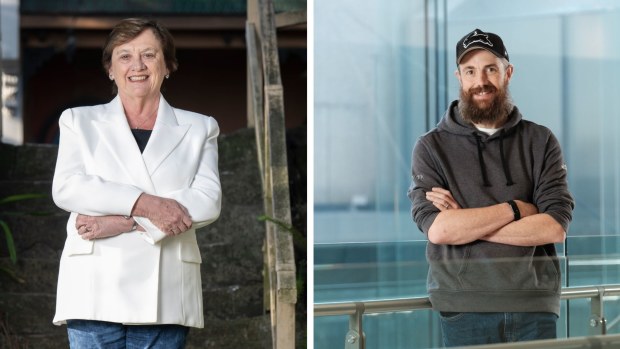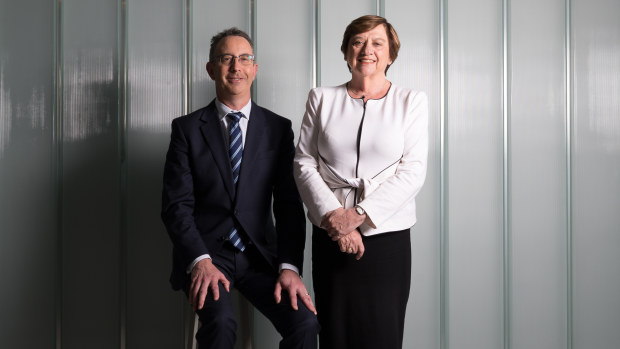AGL bows to shareholders and hastens coal exit
AGL Energy has bowed to pressure from billionaire Mike Cannon-Brookes and will close Australia’s biggest-emitting power plant a decade earlier than planned, but its strategy to develop $20 billion worth of zero emission generation threatens to diminish the returns for other investors over time.
AGL’s accelerated retreat from coal will go a large way to easing tensions with Mr Cannon-Brookes and other activist shareholders, which forced a humiliating backdown on a plan to split the business and scuppered the board’s first pick for chairman.
But other investors are worried about the financial burden of a rapid transition to renewables.
“The quantum of capital needed to even partially replace the coal capacity is eye-watering,” said Mark Samter, senior research analyst at MST Marquee.
“Just how much of those earnings you are happy to see evaporate as a shareholder will determine how much equity you are willing to give to retain part of that earnings stream.
“It is entirely unfathomable to me that AGL won’t be asking you for equity in the near term.”
Mr Cannon-Brookes – who is AGL’s largest shareholder with more than 11 per cent of the company through his Grok Ventures investment vehicle – has led a vocal campaign for AGL to exit coal by 2035, and the 185-year-old company said it would close its coal-fired Loy Yang A power station in Victoria in 2035, having previously said it would retire the generator in 2045.

AGL chairman Patricia McKenzie and billionaire Mike Cannon Brookes.
“We think that is the most viable path that sits in front of us today,” AGL chairman Patricia McKenzie told The Australian Financial Review in an interview. “AGL is committing to an ambitious but achievable strategy to deliver a responsible and accelerated low-carbon future.”
“We have listened to our stakeholders – in particular, our shareholders, as well as government and energy regulatory authorities.”
AGL’s accelerated exit from coal will mean Australia’s once dominant coal power stations will be mothballed by 2035 after Queensland announced a plan to end its dependence on the commodity and have 80 per cent renewable energy by 2035.
Coal, which still accounts for two-thirds of Australia’s electricity needs, will require a rapid increase in new generation and storage.
Victoria on Wednesday said it would increase its storage capacity target to provide enough renewable energy to power half the state’s current homes at peak energy use.
‘Step in the right direction’
A spokesman for Grok Ventures described the move as a “step in the right direction”, but said AGL’s largest shareholder remained unsatisfied with the board composition.
“To make the execution of its plan possible – and to assume the necessary leadership position – AGL needs additional skills around the board table to assist with regulatory engagement, company transformation, people and culture reset, renewables development and harnessing the behind-the-meter opportunity,” he said.
“There is a monumental amount of work ahead to become a leading green gentailer. To achieve this, the board must go further with its renewal – looking to fresh faces to provide a broader mix of skills, experience and capabilities around the table.
“This is why yesterday Grok proposed an additional four independent [non-executive directors] to the board.”
AGL left the closure dates for its other coal power stations, Liddell and Bayswater, unchanged. Liddell closes next year and Bayswater is due to be retired between 2030 and 2033.
The Loy Yang A power station is one of Victoria’s youngest coal-fired power plants, with a capacity of 2.2GW, but it is responsible for about 30 per cent of the state’s total emissions.
New generation
Influential superannuation fund HESTA said more detail was needed, but the early exit from coal was more closely aligned to the goals of the Paris Agreement.
“It’s important key emitters like AGL support a timely, equitable and orderly transition.” said HESTA chief executive Debby Blakey.
Victoria’s state energy minister, Lily D’Ambrosio, said the government would work with AGL to assist the workers affected by the plant’s early closure.
“We will leave no stone unturned in working with AGL to ensure that every support is made available to these workers, their families and their local communities,” she said.
The decarbonisation plan reshapes AGL, Australia’s largest polluter, and aids the country’s net zero by 2050 ambitions, though the rapid timetable away from coal will raise concerns about energy security and stability.
The Energy Security Board’s first annual update on the health of the National Electricity Market, released on Thursday, found the grid required “massive physical investment and wide-ranging policy reforms” which will put ongoing pressure on prices
AGL said it needed to replace 12GW of generation capacity by 2036, which would require a $20 billion investment to be funded from its balance sheet, partnerships and offtakes.
Interim chief executive Damien Nicks said its accelerated coal closures had opened up new financial markets, but heavyweight industry figures said the plan risked shareholders.
Shares fell more than 1 per cent after the announcement, and while losses were recouped, they continued to underperform the broader market.
The required investment matches the figure that Mr Cannon-Brookes said Grok and Brookfield had earmarked when it made its unsuccessful $5 billion offer for Australia’s biggest emitter.
AGL said it needed about 6.5GW of renewable projects, predominantly utility-scale solar and wind schemes.
Board row
To back up and firm this capacity of variable renewable generation AGL is targeting 5.5GW of firming capacity made up of batteries, pumped hydro, and hydrogen-fired peaking generators.

AGL Interim CEO Damien Nicks and AGL Chairman Patricia McKenzie. .
Sourcing new generation capacity is unlikely to be a problem as a flood of developers moves to meet the federal government’s plan for more than 80 per cent of Australia’s electricity needs to be met by renewables.
AGL also said it now expected underlying profit after tax of between $200 million and $320 million, compared to $225 million reported last year.
Grok’s push for four board members has won the support of Snowcap Research and impact investor Sentient Impact Group, which represents $50 million of AGL shares.
AGL’s move to accelerate the coal closure offers an olive branch to Mr Cannon-Brooks amid a period of tension between the energy company and its largest shareholder.
Just hours before AGL was to announce its much anticipated strategy review, Grok Ventures said it would nominate four new candidates to the board of AGL Energy.
They include former Energy Security Board chairwoman Kerry Schott and Professor John Pollaers, as independent non-executive directors, who will be nominated at the company’s annual meeting in November.
Ms McKenzie said the board would make a public recommendation on the nominees next month, but she declined to specify the size of the board the company was looking at.
“I think we need to look at the skills matrix and determine who we need on the board rather than how many. It is about getting the right people on the board to implement this really exciting new strategy,” she said.
Subscribe to gift this article
Gift 5 articles to anyone you choose each month when you subscribe.
Subscribe nowAlready a subscriber?
Introducing your Newsfeed
Follow the topics, people and companies that matter to you.
Find out moreRead More
Latest In Energy
Fetching latest articles